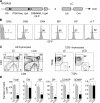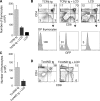The requirement for Notch signaling at the beta-selection checkpoint in vivo is absolute and independent of the pre-T cell receptor
- PMID: 16966428
- PMCID: PMC2118105
- DOI: 10.1084/jem.20061020
The requirement for Notch signaling at the beta-selection checkpoint in vivo is absolute and independent of the pre-T cell receptor
Abstract
Genetic inactivation of Notch signaling in CD4(-)CD8(-) double-negative (DN) thymocytes was previously shown to impair T cell receptor (TCR) gene rearrangement and to cause a partial block in CD4(+)CD8(+) double-positive (DP) thymocyte development in mice. In contrast, in vitro cultures suggested that Notch was absolutely required for the generation of DP thymocytes independent of pre-TCR expression and activity. To resolve the respective role of Notch and the pre-TCR, we inhibited Notch-mediated transcriptional activation in vivo with a green fluorescent protein-tagged dominant-negative Mastermind-like 1 (DNMAML) that allowed us to track single cells incapable of Notch signaling. DNMAML expression in DN cells led to decreased production of DP thymocytes but only to a modest decrease in intracellular TCRbeta expression. DNMAML attenuated the pre-TCR-associated increase in cell size and CD27 expression. TCRbeta or TCRalphabeta transgenes failed to rescue DNMAML-related defects. Intrathymic injections of DNMAML(-) or DNMAML(+) DN thymocytes revealed a complete DN/DP transition block, with production of DNMAML(+) DP thymocytes only from cells undergoing late Notch inactivation. These findings indicate that the Notch requirement during the beta-selection checkpoint in vivo is absolute and independent of the pre-TCR, and it depends on transcriptional activation by Notch via the CSL/RBP-J-MAML complex.
Figures





References
-
- Radtke, F., A. Wilson, S.J. Mancini, and H.R. MacDonald. 2004. Notch regulation of lymphocyte development and function. Nat. Immunol. 5:247–253. - PubMed
-
- Maillard, I., T. Fang, and W.S. Pear. 2005. Regulation of lymphoid development, differentiation and function by the Notch pathway. Annu. Rev. Immunol. 23:945–974. - PubMed
-
- Nam, Y., P. Sliz, L. Song, J.C. Aster, and S.C. Blacklow. 2006. Structural basis for cooperativity in recruitment of MAML coactivators to Notch transcription complexes. Cell. 124:973–983. - PubMed
-
- Radtke, F., A. Wilson, G. Stark, M. Bauer, J. van Meerwijk, H.R. MacDonald, and M. Aguet. 1999. Deficient T cell fate specification in mice with an induced inactivation of Notch1. Immunity. 10:547–558. - PubMed
-
- Sambandam, A., I. Maillard, V.P. Zediak, L. Xu, R. Gerstein, J. Aster, W.S. Pear, and A. Bhandoola. 2005. Notch signaling controls the generation and differentiation of early T lineage progenitors. Nat. Immunol. 6:663–670. - PubMed
Publication types
MeSH terms
Substances
Grants and funding
LinkOut - more resources
Full Text Sources
Other Literature Sources
Molecular Biology Databases
Research Materials

